CatBoost Improves Inversion Accuracy of Plant Water Status in Winter Wheat Using Ratio Vegetation Index
Abstract
1. Introduction
2. Materials and Methods
2.1. Site Description
2.2. Experimental Design
2.3. Data Collection
2.4. Crop Water Status
2.4.1. Crop Water Content
2.4.2. Equivalent Water Thickness (EWT)
2.5. Vegetation Index Calculation
2.6. Machine Learning Algorithms
2.6.1. Random Forest (RF)
2.6.2. Decision Trees (DTs)
2.6.3. Light Gradient Boosting Machine (LightGBM)
2.6.4. Categorical Boosting Algorithm (CatBoost)
2.7. Model Evaluation
2.8. Model Validation and Overfitting Prevention
2.9. Statistical Analysis
3. Results
3.1. Correlation Between CWC and Vegetation Indices
3.2. Correlation Between EWT and Vegetation Indices
3.3. Comparison of Vegetation Indices at Flowering Stage
3.4. Model Accuracy Assessment and Validation
3.4.1. Crop Water Content (CWC)
3.4.2. Equivalent Water Thickness (EWT)
3.5. The CWC and EWT Inversion Map
4. Discussion
4.1. Machine Learning Algorithms in Crop Water Status Prediction
4.2. Vegetation Indices for Winter Wheat Water Status Retrieval
4.3. Real-Time Water Stress Mapping for Precision Irrigation
4.4. Comparative Analysis with the 2023–2024 Growing Season
5. Conclusions
Author Contributions
Funding
Data Availability Statement
Acknowledgments
Conflicts of Interest
References
- Zhao, G.C.; Chang, X.H.; Wang, D.M.; Tao, Z.Q.; Wang, Y.J.; Yang, Y.S.; Zhu, Y.J. General Situation and Development of Wheat Production. Crops 2018, 4, 1–7. [Google Scholar]
- Sharma, K.; Sharma, P.K. Wheat as a Nutritional Powerhouse: Shaping Global Food Security. In Triticum—The Pillar of Global Food Security; IntechOpen: London, UK, 2025; pp. 23–26. [Google Scholar]
- Li, H.; Zhou, Y.; Xin, W.; Wei, Y.; Zhang, J.; Guo, L. Wheat Breeding in Northern China: Achievements and Technical Advances. Crop J. 2019, 7, 718–729. [Google Scholar] [CrossRef]
- Wu, D.; Yu, Q.; Lu, C.; Hengsdijk, H. Quantifying Production Potentials of Winter Wheat in the North China Plain. Eur. J. Agron. 2006, 24, 226–235. [Google Scholar] [CrossRef]
- Sun, S.K.; Li, C.; Wu, P.T.; Zhao, X.N.; Wang, Y.B. Evaluation of Agricultural Water Demand under Future Climate Change Scenarios in the Loess Plateau of Northern Shaanxi, China. Ecol. Indic. 2018, 84, 811–819. [Google Scholar] [CrossRef]
- Laporte, M.F.; Duchesne, L.; Wetzel, S. Effect of Rainfall Patterns on Soil Surface CO2 Efflux, Soil Moisture, Soil Temperature and Plant Growth in a Grassland Ecosystem of Northern Ontario, Canada: Implications for Climate Change. BMC Ecol. 2002, 2, 10. [Google Scholar] [CrossRef] [PubMed]
- Li, Y.; Guan, K.; Schnitkey, G.D.; DeLucia, E.; Peng, B. Excessive Rainfall Leads to Maize Yield Loss of a Comparable Magnitude to Extreme Drought in the United States. Glob. Change Biol. 2019, 25, 2325–2337. [Google Scholar] [CrossRef]
- Knox, J.; Morris, J.; Hess, T. Identifying Future Risks to UK Agricultural Crop Production: Putting Climate Change in Context. Outlook Agric. 2010, 39, 249–256. [Google Scholar] [CrossRef]
- Zeng, R.; Lin, X.; Welch, S.M.; Yang, S.; Huang, N.; Sassenrath, G.F.; Yao, F. Impact of Water Deficit and Irrigation Management on Winter Wheat Yield in China. Agric. Water Manag. 2023, 287, 108431. [Google Scholar] [CrossRef]
- Rey, D.; Holman, I.P.; Daccache, A.; Morris, J.; Weatherhead, E.K.; Knox, J.W. Modelling and Mapping the Economic Value of Supplemental Irrigation in a Humid Climate. Agric. Water Manag. 2016, 173, 13–22. [Google Scholar] [CrossRef]
- Oweis, T. The Role of Water Harvesting and Supplemental Irrigation in Coping with Water Scarcity and Drought in the Dry Areas. In Drought and Water Crises: Science, Technology, and Management Issues; Wilhite, D.A., Ed.; Taylor & Francis: Boca Raton, FL, USA, 2005; pp. 191–213. [Google Scholar]
- Sun, Z.; Herzfeld, T.; Aarnoudse, E.; Yu, C.; Disse, M. China’s Agricultural Sector. In Water and Agriculture in China: Status, Challenges and Options for Action; OAV–German Asia-Pacific Business Association: Hamburg, Germany, 2017; pp. 4–6. [Google Scholar]
- Du, J.; Laghari, Y.; Wei, Y.C.; Wu, L.; He, A.L.; Liu, G.Y.; Yang, H.H.; Guo, Z.Y.; Leghari, S.J. Groundwater Depletion and Degradation in the North China Plain: Challenges and Mitigation Options. Water 2024, 16, 354. [Google Scholar] [CrossRef]
- Cai, X. Water Stress, Water Transfer and Social Equity in Northern China—Implications for Policy Reforms. J. Environ. Manag. 2008, 87, 14–25. [Google Scholar] [CrossRef]
- Bwambale, E.; Abagale, F.K.; Anornu, G.K. Smart Irrigation Monitoring and Control Strategies for Improving Water Use Efficiency in Precision Agriculture: A Review. Agric. Water Manag. 2022, 260, 107324. [Google Scholar] [CrossRef]
- Zhang, Z.; Dou, G.; Zhao, X.; Gao, Y.; Liu, S.; Qin, A. Inversion of Crop Water Content Using Multispectral Data and Machine Learning Algorithms in the North China Plain. Agronomy 2024, 14, 2361. [Google Scholar] [CrossRef]
- Traore, A.; Ata-Ul-Karim, S.T.; Duan, A.; Soothar, M.K.; Traore, S.; Zhao, B. Predicting Equivalent Water Thickness in Wheat Using UAV Mounted Multispectral Sensor through Deep Learning Techniques. Remote Sens. 2021, 13, 4476. [Google Scholar] [CrossRef]
- Yang, G.; Liu, J.; Zhao, C.; Li, Z.; Huang, Y.; Yu, H.; Xu, B.; Yang, X.; Zhu, D.; Zhang, X.; et al. Unmanned Aerial Vehicle Remote Sensing for Field-Based Crop Phenotyping: Current Status and Perspectives. Front. Plant Sci. 2017, 8, 1111. [Google Scholar] [CrossRef]
- Zhang, Z.; Zhu, L. A Review on Unmanned Aerial Vehicle Remote Sensing: Platforms, Sensors, Data Processing Methods, and Applications. Drones 2023, 7, 398. [Google Scholar] [CrossRef]
- Xue, J.; Su, B. Significant Remote Sensing Vegetation Indices: A Review of Developments and Applications. J. Sens. 2017, 2017, 135369. [Google Scholar] [CrossRef]
- Rahman, A.; Street, J.; Wooten, J.; Marufuzzaman, M.; Gude, V.G.; Buchanan, R.; Wang, H. MoistNet: Machine Vision-Based Deep Learning Models for Wood Chip Moisture Content Measurement. Expert Syst. Appl. 2025, 259, 12536. [Google Scholar] [CrossRef]
- Yang, M.D.; Hsu, Y.C.; Tseng, W.C.; Tseng, H.H.; Lai, M.H. Precision Assessment of Rice Grain Moisture Content Using UAV Multispectral Imagery and Machine Learning. Comput. Electron. Agric. 2025, 230, 109813. [Google Scholar] [CrossRef]
- Yu, J.; Lan, C.; Zhou, Y.; Wang, S. Retrieval of Water Content of Crop Based on Remote Sensing. Geomat. Info. Sci. Wuhan Univers. 2009, 34, 210–213. [Google Scholar]
- Li, Z.; Cheng, Q.; Chen, L.; Zhai, W.; Zhang, B.; Mao, B.; Li, Y.; Ding, F.; Zhou, X.; Chen, Z. Novel Spectral Indices and Transfer Learning Model in Estimat Moisture Status across Winter Wheat and Summer Maize. Comput. Electron. Agric. 2025, 229, 109762. [Google Scholar] [CrossRef]
- Barbierato, E.; Gatti, A. The Challenges of Machine Learning: A Critical Review. Electronics 2024, 13, 416. [Google Scholar] [CrossRef]
- Ahmad, U.; Alvino, A.; Marino, S. A Review of Crop Water Stress Assessment Using Remote Sensing. Remote Sens. 2021, 13, 4155. [Google Scholar] [CrossRef]
- Clevers, J.G.P.W.; Kooistra, L.; Schaepman, M.E. Using Spectral Information from the NIR Water Absorption Features for the Retrieval of Canopy Water Content. Int. J. Appl. Earth Obs. Geoinf. 2008, 10, 388–397. [Google Scholar] [CrossRef]
- Hunt, E.R.; Rock, B.N. Detection of Changes in Leaf Water Content Using Near- and Middle-Infrared Reflectances. Remote Sens. Environ. 1989, 30, 43–54. [Google Scholar]
- Clevers, J.G.P.W.; Kooistra, L.; Schaepman, M.E. Estimating Canopy Water Content Using Hyperspectral Remote Sensing Data. Int. J. Appl. Earth Obs. Geoinf. 2010, 12, 119–125. [Google Scholar] [CrossRef]
- Huete, A.R. A Soil-Adjusted Vegetation Index (SAVI). Remote Sens. Environ. 1988, 25, 295–309. [Google Scholar] [CrossRef]
- Gitelson, A.A.; Gritz, Y.; Merzlyak, M.N. Relationships between Leaf Chlorophyll Content and Spectral Reflectance and Algorithms for Non-Destructive Chlorophyll Assessment in Higher Plant Leaves. J. Plant Physiol. 2003, 160, 271–282. [Google Scholar] [CrossRef]
- Rondeaux, G.; Steven, M.; Baret, F. Optimization of Soil-Adjusted Vegetation Indices. Remote Sens. Environ. 1996, 55, 95–107. [Google Scholar] [CrossRef]
- Lu, J.; Miao, Y.; Shi, W.; Li, J.; Yuan, F. Evaluating Different Approaches to Non-Destructive Nitrogen Status Diagnosis of Rice Using Portable RapidSCAN Active Canopy Sensor. Sci. Rep. 2017, 7, 14073. [Google Scholar] [CrossRef]
- Kanke, Y.; Tubaña, B.; Dalen, M.; Harrell, D. Evaluation of Red and Red-Edge Reflectance-Based Vegetation Indices for Rice Biomass and Grain Yield Prediction Models in Paddy Fields. Precis. Agric. 2016, 17, 507–530. [Google Scholar]
- Broge, N.H.; Mortensen, J.V. Deriving Green Crop Area Index and Canopy Chlorophyll Density of Winter Wheat from Spectral Reflectance Data. Remote Sens. Environ. 2002, 81, 45–57. [Google Scholar]
- Broge, N.H.; Leblanc, E. Comparing Prediction Power and Stability of Broadband and Hyperspectral Vegetation Indices for Estimation of Green Leaf Area Index and Canopy Chlorophyll Density. Remote Sens. Environ. 2001, 76, 156–172. [Google Scholar]
- Datt, B. A New Reflectance Index for Remote Sensing of Chlorophyll Content in Higher Plants: Tests Using Eucalyptus Leaves. J. Plant Physiol. 1999, 154, 30–36. [Google Scholar] [CrossRef]
- Tucker, C.J. Red and Photographic Infrared Linear Combinations for Monitoring Vegetation. Remote Sens. Environ. 1979, 8, 127–150. [Google Scholar] [CrossRef]
- Datt, B. Remote Sensing of Water Content in Eucalyptus Leaves. Aust. J. Bot. 1999, 47, 909–923. [Google Scholar] [CrossRef]
- Thompson, C.N.; Guo, W.; Sharma, B.; Ritchie, G.L. Using Normalized Difference Red Edge Index to Assess Maturity in Cotton. Crop Sci. 2019, 59, 2167–2177. [Google Scholar]
- Tucker, C.J.; Vanpraet, C.L.; Sharman, M.J.; Ittersum, G.V. Satellite Remote Sensing of Total Herbaceous Biomass Production in the Senegalese Sahel: 1980–1984. Remote Sens. Environ. 1985, 17, 233–249. [Google Scholar] [CrossRef]
- Haboudane, D.; Miller, J.R.; Tremblay, N.; Zarco-Tejada, P.J.; Dextraze, L. Integrated Narrow-Band Vegetation Indices for Prediction of Crop Chlorophyll Content for Application to Precision Agriculture. Remote Sens. Environ. 2002, 81, 416–426. [Google Scholar]
- Elsherbiny, O.; Fan, Y.; Zhou, L.; Qiu, Z. Fusion of Feature Selection Methods and Regression Algorithms for Predicting the Canopy Water Content of Rice Based on Hyperspectral Data. Agriculture 2021, 11, 51. [Google Scholar] [CrossRef]
- Fawagreh, K.; Gaber, M.M.; Elyan, E. Random Forests: From Early Developments to Recent Advancements. Syst. Sci. Control. Eng. Open Access J. 2014, 2, 602–609. [Google Scholar]
- Kotsiantis, S.B. Decision Trees: A Recent Overview. Artif. Intell. Rev. 2013, 39, 261–283. [Google Scholar]
- Pan, Z.; Lu, W.; Bai, Y. Groundwater Contaminated Source Estimation Based on Adaptive Correction Iterative Ensemble Smoother with an Auto Lightgbm Surrogate. J. Hydrol. 2023, 620, 129502. [Google Scholar] [CrossRef]
- Ke, G.; Meng, Q.; Finley, T.; Wang, T.; Chen, W.; Ma, W.; Ye, Q.; Liu, T.Y. LightGBM: A Highly Efficient Gradient Boosting Decision Tree. In Proceedings of the 31st Conference on Neural Information Processing Systems (NIPS 2017), Long Beach, CA, USA, 4–9 December 2017. [Google Scholar]
- Prokhorenkova, L.; Gusev, G.; Vorobev, A.; Dorogush, A.V.; Gulin, A. CatBoost: Unbiased boosting with categorical features. In Proceedings of the 32nd International Conference on Neural Information Processing System, Montréal, QC, Canada, 3–8 December 2018. [Google Scholar]
- Hancock, J.T.; Khoshgoftaar, T.M. CatBoost for Big Data: An Interdisciplinary Review. J. Big Data 2020, 7, 94. [Google Scholar] [CrossRef]
- Rahila, A.; Umut, H.; Abdugheni, A.; Nijat, K. Hyperspectral Estimation of Spring Wheat Leaf Water Content Based on Machine Learning. J. Triticeae Crops 2022, 42, 640–648. [Google Scholar]
- Jin, N.; Zhang, D.; Li, Z.; He, L. Evaluation of Water Status of Winter Wheat Based on Simulated Reflectance of Multispectral Satellites. Trans. Chin. Soc. Agric. Mach. 2020, 51, 243–252. [Google Scholar]
- Wang, J.; Lou, Y.; Wang, W.; Liu, S.; Zhang, H.; Hui, X.; Wang, Y.; Yan, H.; Maes, W.H. A Robust Model for Diagnosing Water Stress of Winter Wheat by Combining UAV Multispectral and Thermal Remote Sensing. Agric. Water Manag. 2024, 291, 108616. [Google Scholar]
- Yang, S.; Li, Y.; Wang, X.; Yang, Z.; Xu, L.; Hong, Z.; Pan, H.; Chen, C. SHW-Stacking: A Weighted Stacking Method for Enhancing the Accuracy of Remote Sensing Daily Precipitation Products by Capturing Precipitation Spatial Heterogeneity. J. Geo-Inf. Sci. 2025, 27, 1179–1194. [Google Scholar]
- Chlingaryan, A.; Sukkarieh, S.; Whelan, B. Machine Learning Approaches for Crop Yield Prediction and Nitrogen Status Estimation in Precision Agriculture: A Review. Comput. Electron. Agric. 2018, 151, 61–69. [Google Scholar] [CrossRef]
- Virnodkar, S.S.; Pachghare, V.K.; Patil, V.C.; Jha, S.K. Remote Sensing and Machine Learning for Crop Water Stress Determination in Various Crops: A Critical Review. Precis. Agric. 2020, 21, 1121–1155. [Google Scholar] [CrossRef]
- Chandel, N.S.; Chakraborty, S.K.; Rajwade, Y.A.; Dubey, K.; Tiwari, M.K.; Jat, D. Identifying Crop Water Stress Using Deep Learning Models. Neural Comput. Appl. 2021, 33, 5353–5367. [Google Scholar] [CrossRef]
- Zhang, Y.; Zhao, Z.; Zheng, J. CatBoost: A New Approach for Estimating Daily Reference Crop Evapotranspiration in Arid and Semi-Arid Regions of Northern China. J. Hydrol. 2020, 588, 125087. [Google Scholar] [CrossRef]
- Zheng, R.; Jia, Y.; Ullagaddi, C.; Allen, C.; Rausch, K.; Singh, V.; Schnable, J.C.; Kamruzzaman, M. Optimizing Feature Selection with Gradient Boosting Machines in PLS Regression for Predicting Moisture and Protein in Multi-Country Corn Kernels via NIR Spectroscopy. Food Chem. 2024, 456, 140062. [Google Scholar] [CrossRef] [PubMed]
- Miao, H.; Zhang, R.; Song, Z.; Chang, Q. Estimating Winter Wheat Canopy Chlorophyll Content Through the Integration of Unmanned Aerial Vehicle Spectral and Textural Insights. Remote Sens. 2025, 17, 406. [Google Scholar] [CrossRef]
- Zhang, J.; Han, W.; Huang, L.; Zhang, Z.; Ma, Y.; Hu, Y. Leaf Chlorophyll Content Estimation of Winter Wheat Based on Visible and Near-Infrared Sensors. Sensors 2016, 16, 437. [Google Scholar] [CrossRef]
- Li, Q.; Gao, M.; Li, Z.L. Ground Hyper-Spectral Remote-Sensing Monitoring of Wheat Water Stress during Different Growing Stages. Agronomy 2022, 12, 2267. [Google Scholar] [CrossRef]
- Ceccato, P.; Flasse, S.; Tarantola, S.; Jacquemoud, S.; Grégoire, J.M. Detecting vegetation leaf water content using reflectance in the optical domain. Remote Sens. Environ. 2001, 77, 22–33. [Google Scholar] [CrossRef]
- Ceccato, P.; Gobron, N.; Flasse, S.; Pinty, B.; Tarantola, S. Designing a spectral index to estimate vegetation water content from remote sensing data: Part 2. Validation and applications. Remote Sens. Environ. 2002, 82, 198–207. [Google Scholar] [CrossRef]
- O’Shaughnessy, S.A.; Evett, S.R.; Andrade, A.; Workneh, F.; Price, J.A.; Rush, C.M. Site-specific variable-rate irrigation as a means to enhance water use efficiency. Am. Soc. Agric. Biol. Eng. 2016, 59, 239–249. [Google Scholar]
- Maimaitijiang, M.; Sagan, V.; Sidike, P.; Daloye, A.M.; Erkbol, H.; Fritschi, F.B. Crop Monitoring Using Satellite/UAV Data Fusion and Machine Learning. Remote Sens. 2020, 12, 1357. [Google Scholar] [CrossRef]
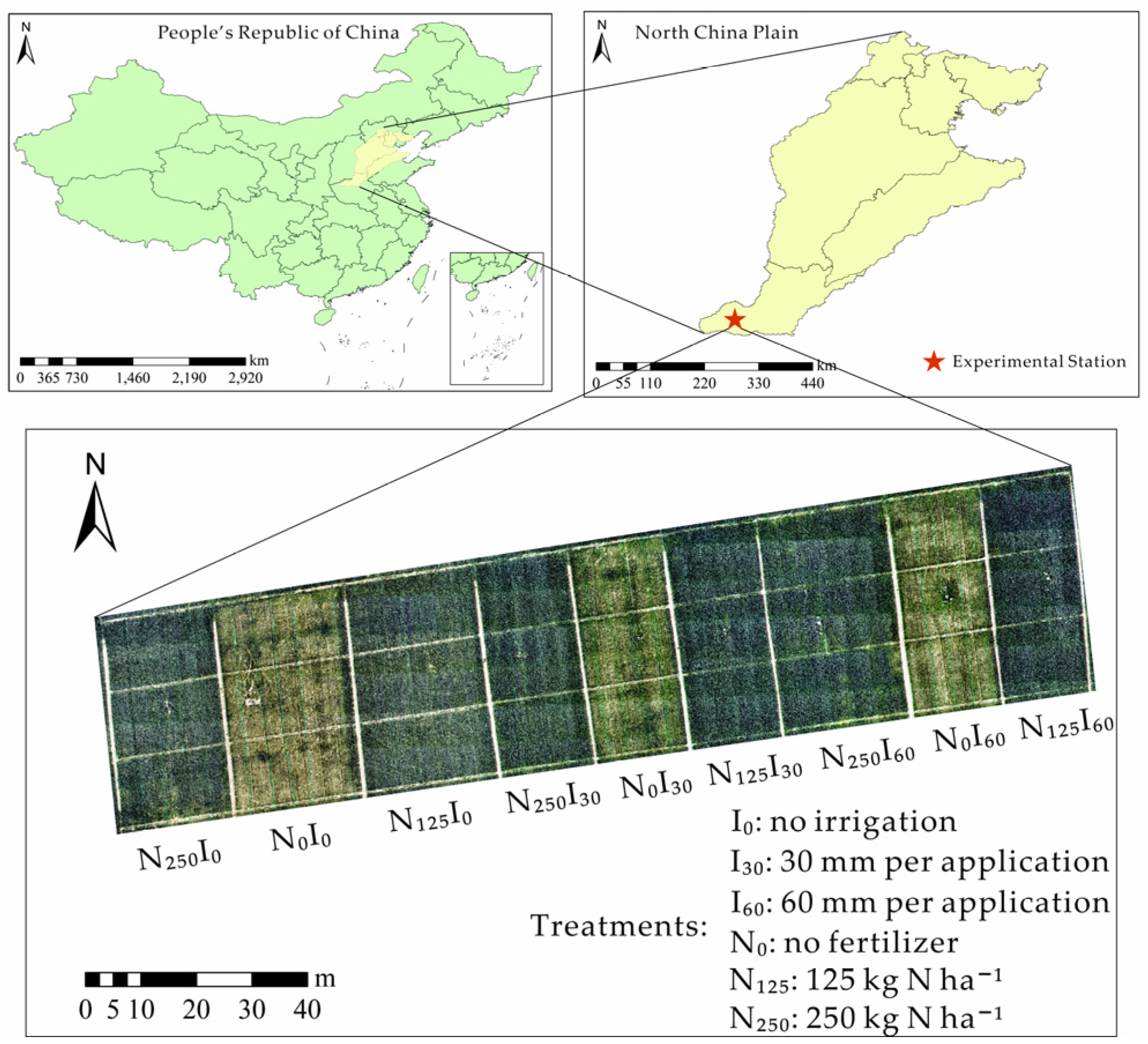
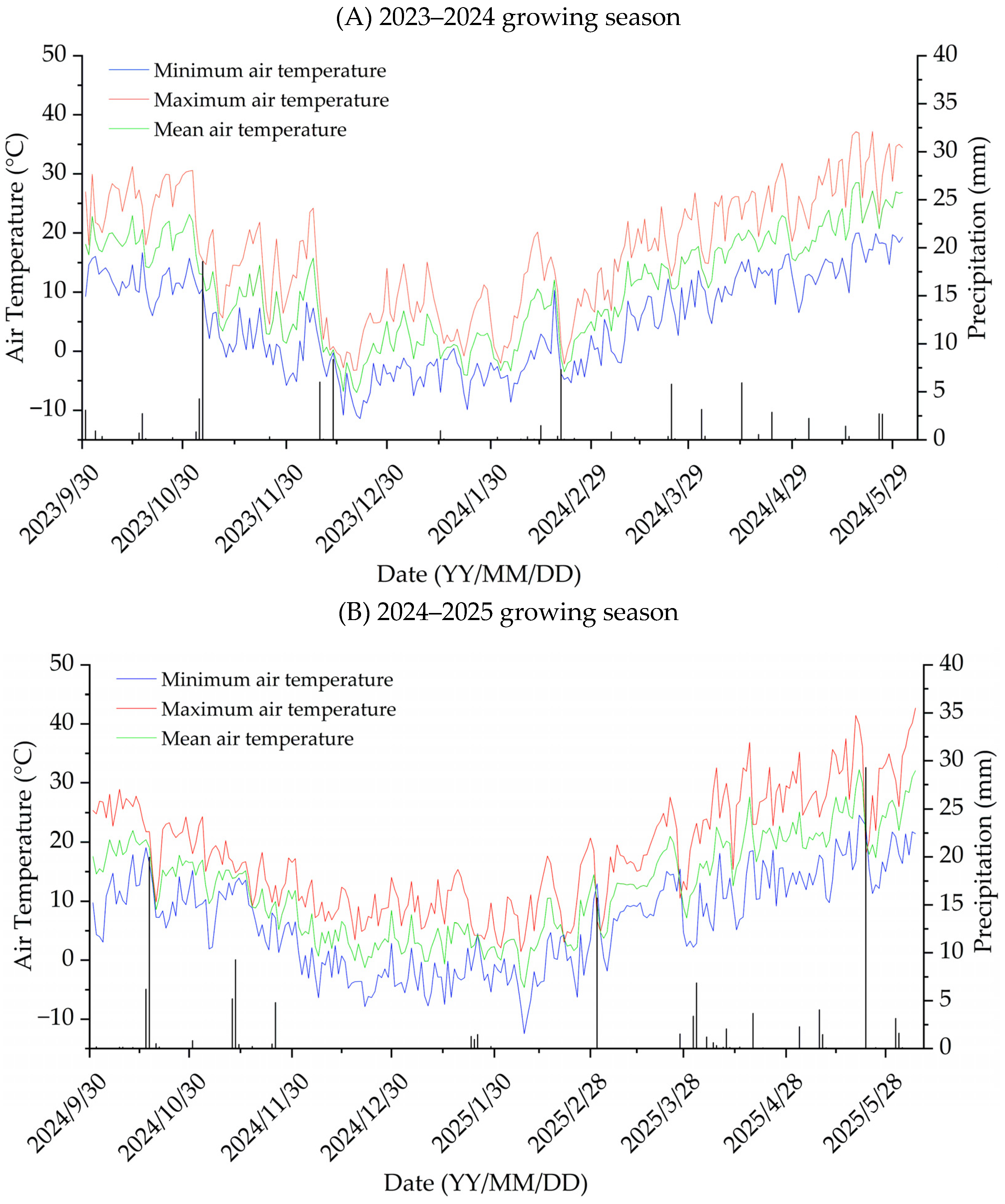
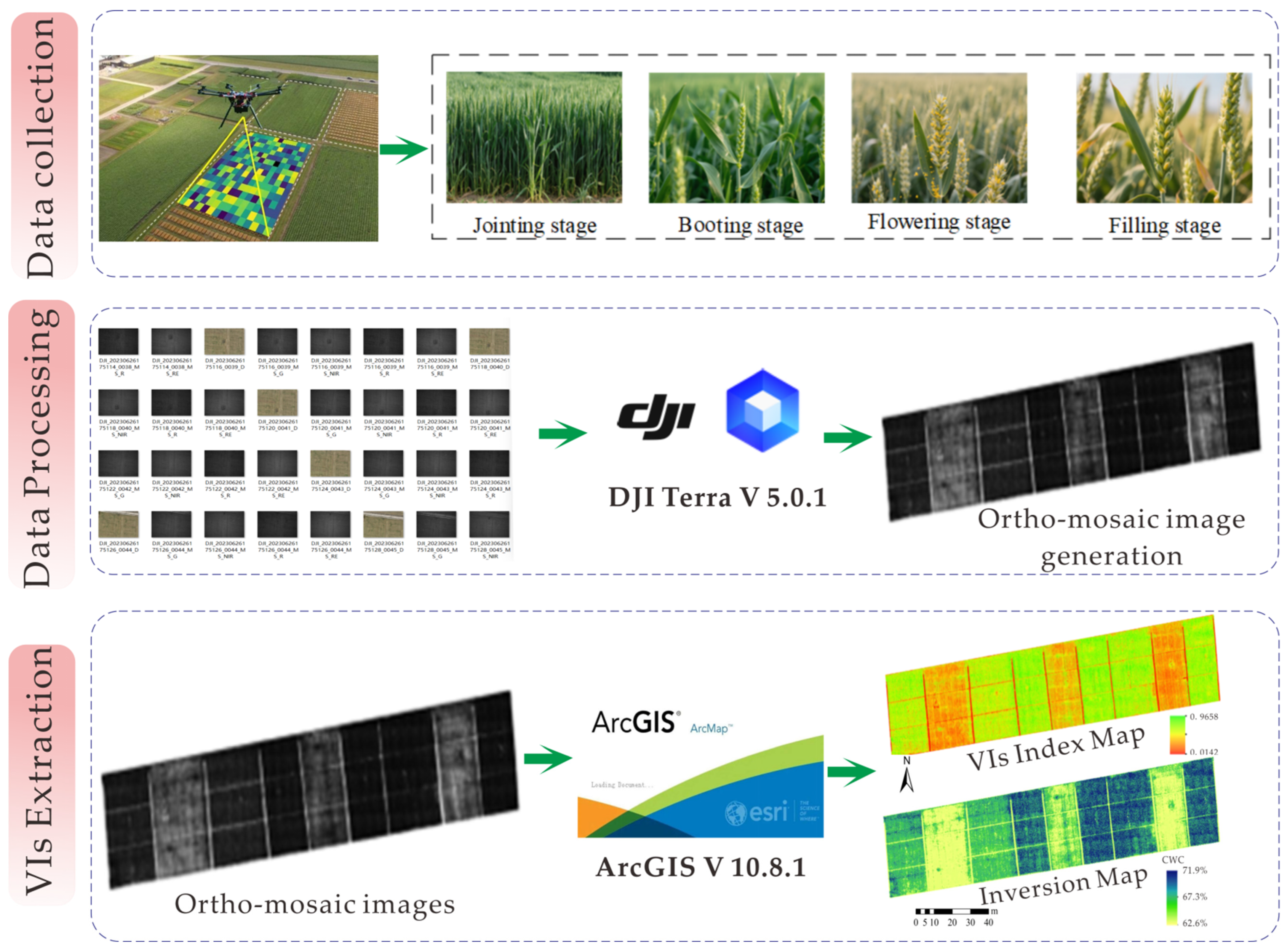
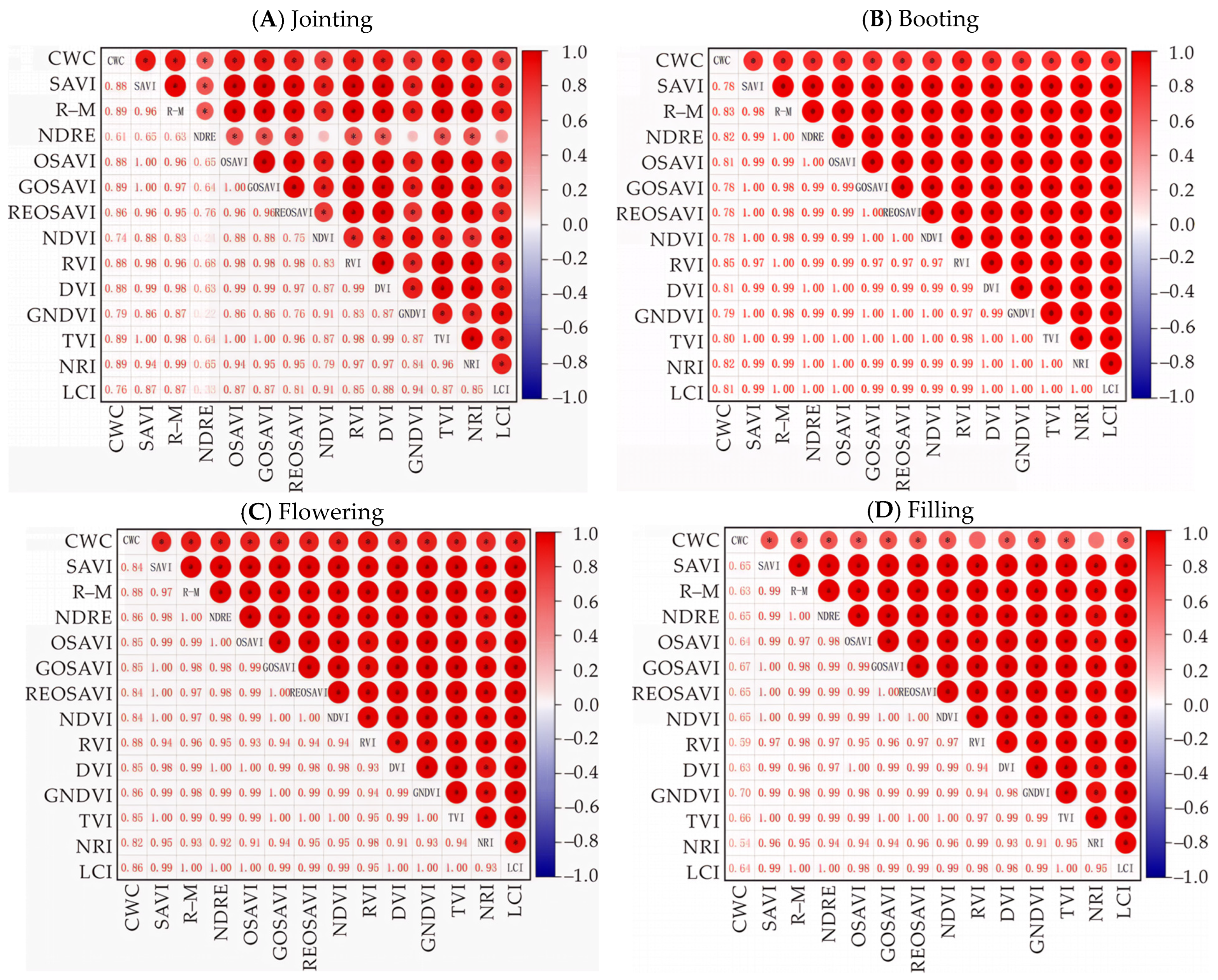
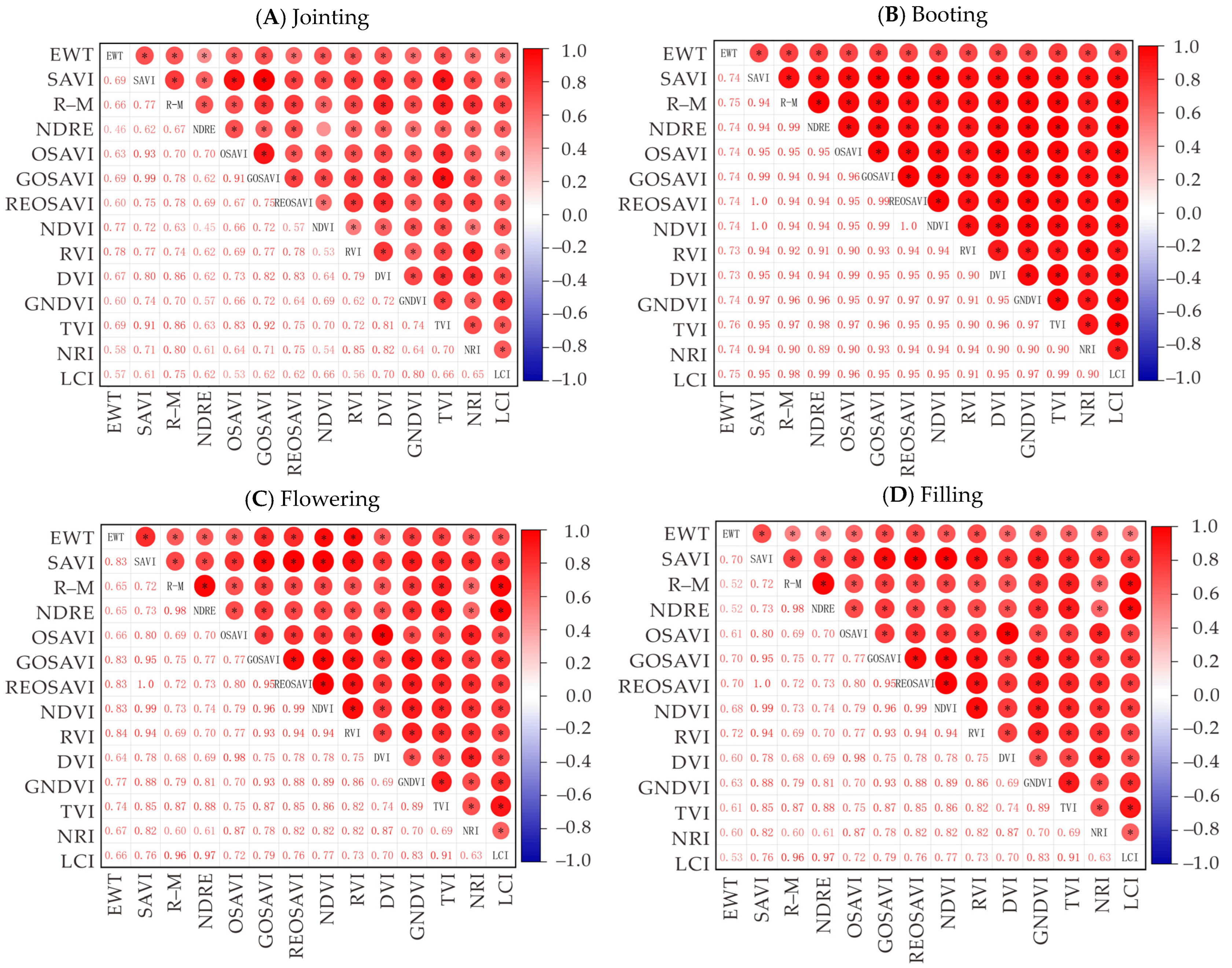
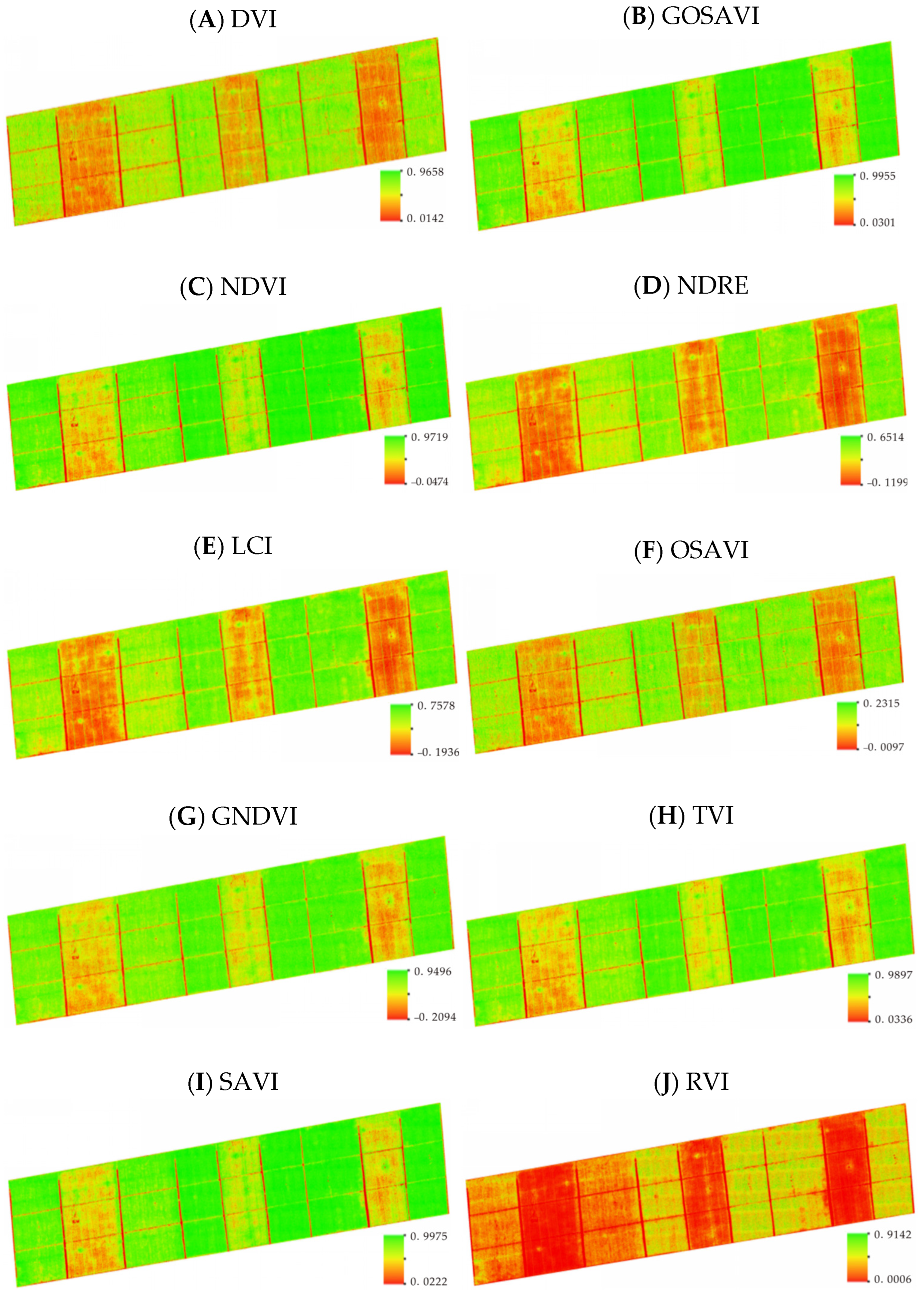
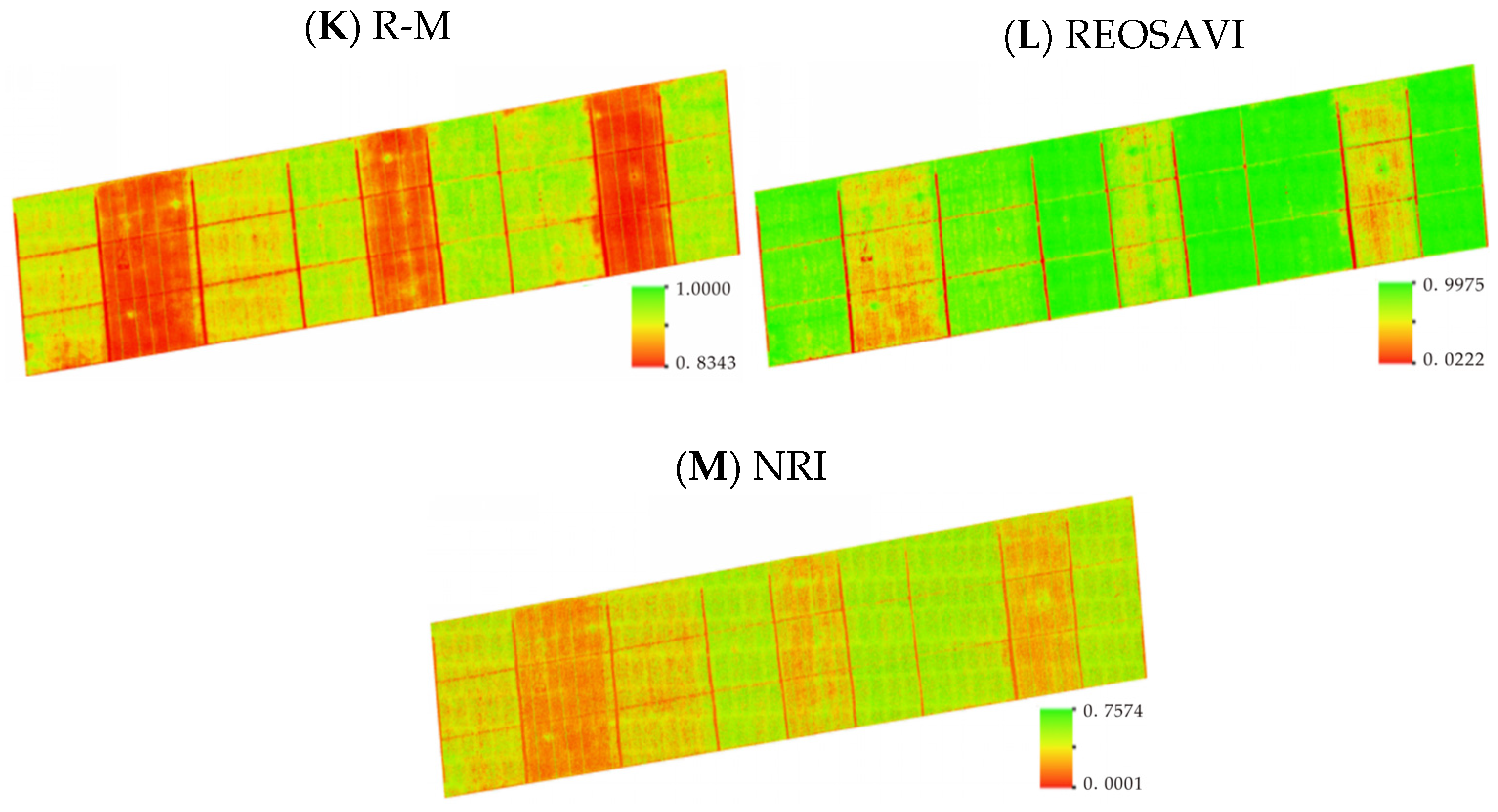

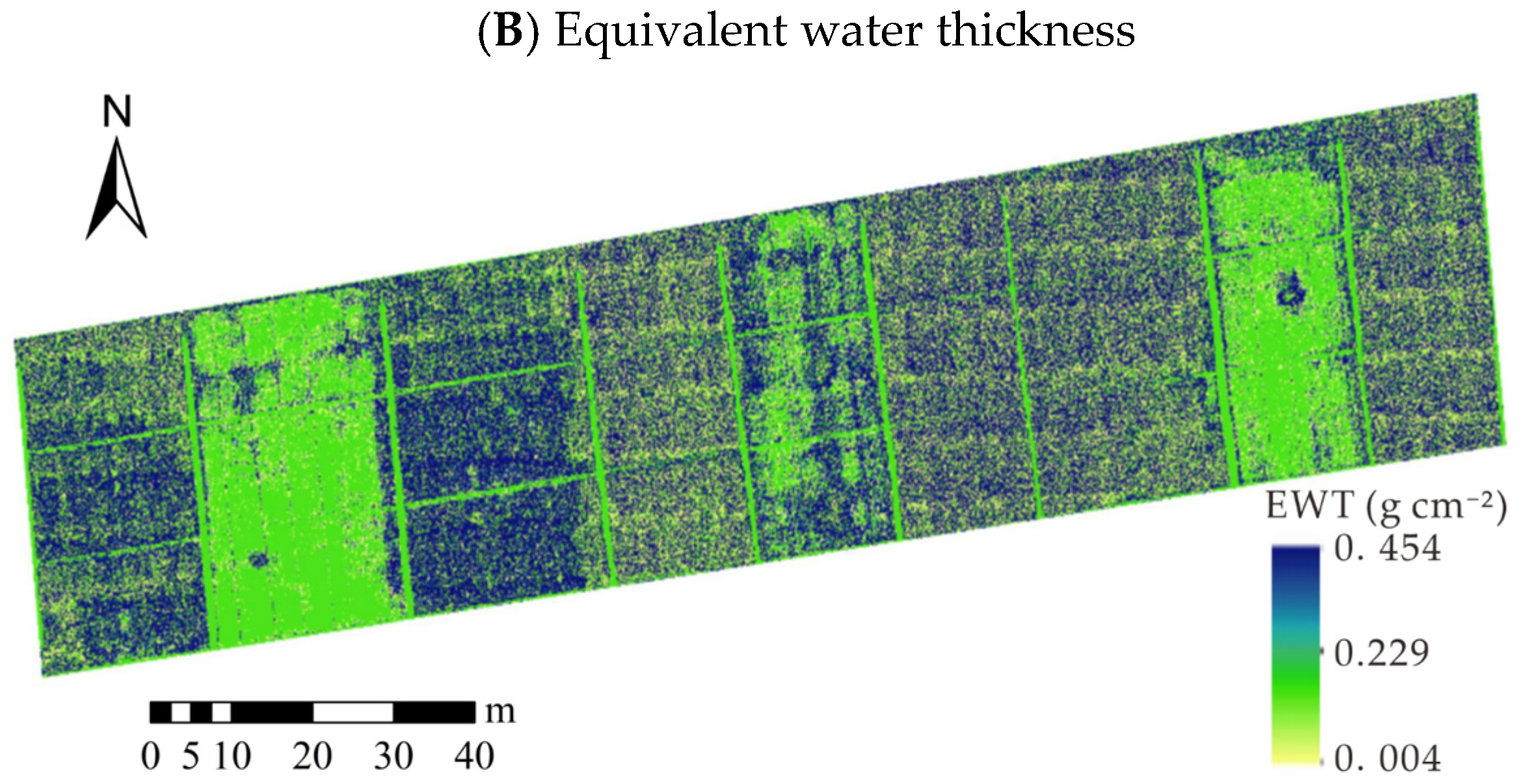
| Vegetation Indices | Formulae | References |
|---|---|---|
| Soil-adjusted vegetation index (SAVI) | (1 + 0.5)(NIR − R)/(NIR + R + 0.5) | [30] |
| Red-edge model(R-M) | NIR/(RE − 1) | [31] |
| Green-band-optimized soil-adjusted vegetation index (GOSAVI) | (NIR − R)/(NIR + G + 0.16) | [32] |
| Red-edge-optimized soil-adjusted vegetation index (REOSAVI) | (NIR − R)/(NIR + R + 0.16) | [33] |
| Ratio vegetation index (RVI) | NIR/R | [34] |
| Difference vegetation index (DVI) | NIR − R | [35] |
| Triangle vegetation index (TVI) | 1.5(NIR − R)/(NIR + RE + 0.5) | [36] |
| Crop nitrogen response index (NRI) | (G − R)/(G + R) | [37] |
| Green normalized vegetation difference index (GNDVI) | (NIR − G)/(NIR + G) | [38] |
| Leaf chlorophyll index (LCI) | (NIR − RE)/(NIR + R) | [39] |
| Normalized red-edge vegetation index(NDRE) | (NIR − RE)/(NIR + RE) | [40] |
| Normalized difference vegetation index (NDVI) | (NIR − R)/(NIR + R) | [41] |
| Optimized soil-adjusted vegetation index (OSAVI) | (NIR − R)/(NIR + R + 0.16) | [42] |
| Years | Model | Training Set | Test Set | ||||
|---|---|---|---|---|---|---|---|
| R2 | RMSE (%) | RPD | R2 | RMSE (%) | RPD | ||
| 2023–2024 | MLR | 0.6277 | 2.4947 | 1.6517 | 0.6230 | 2.5600 | 1.6493 |
| RF | 0.9407 | 1.3237 | 3.8200 | 0.6500 | 2.1077 | 2.0450 | |
| ElasticNet | 0.5817 | 2.8267 | 1.3667 | 0.6760 | 2.7023 | 1.5523 | |
| Ridge | 0.5997 | 2.8490 | 1.6000 | 0.6830 | 2.7593 | 1.8477 | |
| PLSR | 0.5900 | 2.5373 | 1.5850 | 0.6760 | 2.8763 | 1.8127 | |
| 2024–2025 | RF | 0.9643 | 0.0261 | 5.2952 | 0.9003 | 0.035 | 3.1673 |
| DT | 0.9743 | 0.0221 | 6.2344 | 0.8547 | 0.0423 | 2.623 | |
| LightGBM | 0.9349 | 0.0352 | 3.9186 | 0.7815 | 0.0519 | 2.1394 | |
| CatBoost | 0.9924 | 0.0121 | 11.4355 | 0.8934 | 0.0362 | 3.0625 | |
| Model | Training Set | Test Set | ||||
|---|---|---|---|---|---|---|
| R2 | RMSE (g cm−2) | RPD | R2 | RMSE (g cm−2) | RPD | |
| RF | 0.8451 | 0.3852 | 2.5407 | 0.1654 | 0.8081 | 1.0946 |
| DT | 0.8868 | 0.3292 | 2.9722 | 0.2531 | 1.2387 | 0.7141 |
| LightGBM | 0.8376 | 0.3944 | 2.4811 | 0.4192 | 0.6742 | 1.3122 |
| CatBoost | 0.9620 | 0.1907 | 5.1321 | 0.9608 | 0.5645 | 3.1571 |
Disclaimer/Publisher’s Note: The statements, opinions and data contained in all publications are solely those of the individual author(s) and contributor(s) and not of MDPI and/or the editor(s). MDPI and/or the editor(s) disclaim responsibility for any injury to people or property resulting from any ideas, methods, instructions or products referred to in the content. |
© 2025 by the authors. Licensee MDPI, Basel, Switzerland. This article is an open access article distributed under the terms and conditions of the Creative Commons Attribution (CC BY) license (https://creativecommons.org/licenses/by/4.0/).
Share and Cite
Dong, B.; Ma, S.; Gao, Z.; Qin, A. CatBoost Improves Inversion Accuracy of Plant Water Status in Winter Wheat Using Ratio Vegetation Index. Appl. Sci. 2025, 15, 11363. https://doi.org/10.3390/app152111363
Dong B, Ma S, Gao Z, Qin A. CatBoost Improves Inversion Accuracy of Plant Water Status in Winter Wheat Using Ratio Vegetation Index. Applied Sciences. 2025; 15(21):11363. https://doi.org/10.3390/app152111363
Chicago/Turabian StyleDong, Bingyan, Shouchen Ma, Zhenhao Gao, and Anzhen Qin. 2025. "CatBoost Improves Inversion Accuracy of Plant Water Status in Winter Wheat Using Ratio Vegetation Index" Applied Sciences 15, no. 21: 11363. https://doi.org/10.3390/app152111363
APA StyleDong, B., Ma, S., Gao, Z., & Qin, A. (2025). CatBoost Improves Inversion Accuracy of Plant Water Status in Winter Wheat Using Ratio Vegetation Index. Applied Sciences, 15(21), 11363. https://doi.org/10.3390/app152111363










